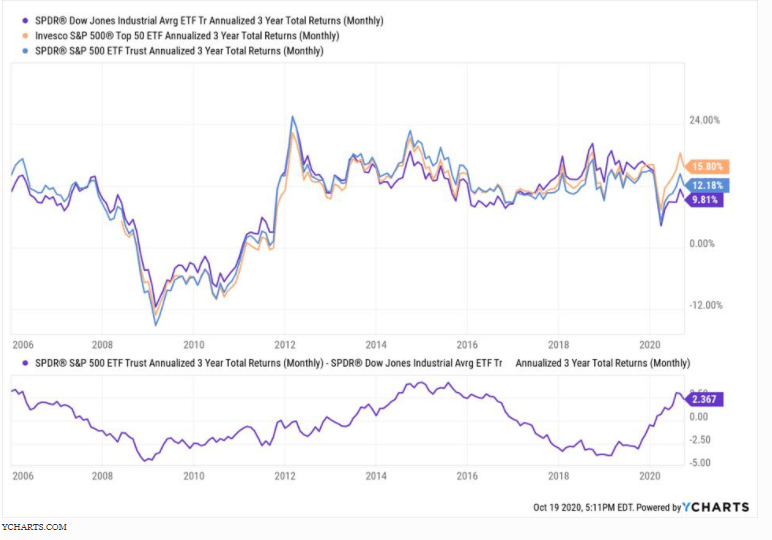Do you need 500 stocks when only 30 will do?
I have written extensively on the S&P 500 and Dow Jones Industrial Average. They are perhaps the 2 most common answers to the question “what do you consider to be the stock market?” They help put a framework around investing in U.S. stocks. They are very different, yet very similar.
The Dow used to be “the market” to many investors. Actually, much of its current appeal as a market gauge may be due to the fact that most wealth is owned by people old enough to remember when the S&P 500 was really just for investment professional use.
Over the years, the flood of money into index funds has launched the S&P 500 right past the Dow. When the committee that oversees the Dow index replaced 4 of its 30 stocks with different ones, the world of index investing barely noticed. That’s because, in relative terms, there is very little money indexed to the Dow. The S&P 500 is where the vast majority of large cap U.S. stock index fund assets are.
Those are all interesting observations for market geeks. But what about you?
If you are trying to figure out how you should own “the stock market,” there are many choices. But I am ready to make an argument that many in my field may not. Specifically, over time, owning the Dow, with a mere 30 stocks, is substantially similar to owning the S&P 500 Index. This chart shows why.

For well over a decade, the Dow and S&P 500 have moved largely in tandem. I also included an ETF that tracks the 50 largest stocks. In other words, sort of a mini-S&P 500, since the latter index has been so top-heavy for a while anyway.
Splitting hairs
Over about the past 14 years, guess what? All 3 end up within 4% of each other. That’s in total, over 14 years! Translation: who needs 500 stocks when 30, or perhaps 50, will do?
I applied one additional “stress test” to this. As you see below, when we plot 3-year “rolling” returns, the Dow and S&P 500 run parallel much of the time. But even when they don’t, the difference is not a matter of financial life or death. And, as the first graph showed, they even out over time.

The lower part of this chart says that the S&P 500 and Dow take turns winning versus each other. However, the widest gap either way is about 3-4% per year for 3 years. In an environment where double-digit returns in the broad stock market have been common, this is somewhat notable.
Alright then, we’ll call it a draw (with apologies to Monty Python and the Holy Grail)
But as we saw, outperformance of S&P 500 over Dow, or vice-versa, tends to run in cycles. You can see it in the lower part of that chart. My conclusion, based on the data: the Dow and the S&P 500 battle to a draw over the long-run.
How do we use this information? There are an infinite number of ways, but I want to focus on just one (you’re welcome!).
If you aim to own an index fund for a long time, holding it but not selling it, there are scores of S&P 500-indexed funds you can own. They are easy to find.
However, if your focus is to get market-like returns or better, but do so by owning individual stocks instead of buying “the market,” trying to slice and dice through 500 stocks may not fit your time budget. What’s the shortcut? Well, since there are 30 stocks in the Dow, that’s a good place to start. And, if you want to expand your range a bit, the 50 largest companies tend to track the overall S&P 500 quite closely as well.
Making the complicated, less so
I think that too many investors make stock-picking more complicated than it needs to be. If you fashion yourself a whiz-kid stock investor who can identify that next super stock, then do your thing. But if you are a more established investor, who wants to participate in the stock market, but do so through individual stocks, the Dow offers a nice starting point. Sure, it lacks the fire-power of the full menu of FAANG stocks and such. But, this is only one part of your portfolio, after all.
This article was not about what to invest in. It was about thinking through your investment research process. When that is the task, keeping your focus on your personal end goal is the thing. Sometimes in stock selection, less is more. Or, in the case of the S&P 500 and the Dow Jones Industrial Average, less and more are about the same!
Related: 3 Pre-Election Investment Trends Flying Under The Radar


